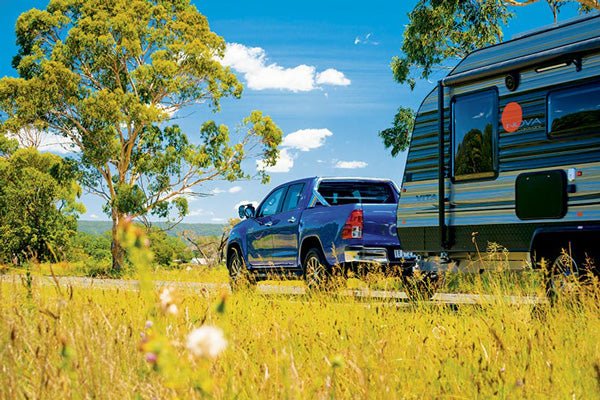TOYOTA HILUX SR5 DUAL-CAB: TOW TEST

Commercial vehicles often have a much longer life-cycle than passenger cars, but even for a ute the HiLux was getting long in the tooth when it was finally replaced late last year after 10 years’ service (without change). It appears the wait was worth it because, unlike many ‘new’ Toyota 4WDs, almost everything in the 2016 NG Series is new.
ATTRIBUTES
The HiLux 4x4 double-cab range continues with 2.8L turbodiesel (or petrol V6) SR and SR5 but are joined by a new entry-level model, the 2.4L turbodiesel Workmate. The top-shelf SR5 has a new option package, the SR5+, which adds leather seats and power driver’s seat adjustment for $2000. Metallic paint is a $550 option.
ENGINE AND TRANSMISSION
The 2.8L engine in the vehicle we tested is Euro 5-compliant, has 25 per cent more torque than the superseded 3L and uses a timing chain rather than a timing belt, reducing maintenance costs. The engine’s key features are a new variable-vane turbocharger with intercooler, a water-cooled exhaust gas recirculation system with a cooler bypass and a diesel particulate filter to minimise emissions. The six-speed auto is new, as are the rear prop shaft and rear diff, while the radiator gains 10 per cent in thermal efficiency.
SUSPENSION
The HiLux’s double-wishbone front and leaf-spring rear suspension has been fettled for local conditions. Rear-wheel articulation has increased to 520mm (previously 433mm
on the left and 474mm on the right) and front suspension has a new, thicker front stabiliser bar to increase roll stiffness.
The rear suspension has been redesigned, with 100mm-longer leaves, wider spacing of the springs and revised attachment points to improve ride and dynamics. There are larger-diameter shocks and a new location for the rear dampers for increased durability and stability and more effective control of small vibrations. Local input also saw the hydraulic power steering tuned to better suit Aussie requirements.
ECONOMY
The HiLux averaged 8.2L/100km in a variety of conditions, from city traffic to highway cruising. With a 2400kg caravan behind, fuel consumption averaged 16.4L/100km.
THE BOTTOM LINE
The new HiLux is a subtle improvement over the old model, with the biggest change for caravanners being its much-improved towing capacity. In this instance, its performance when towing was not great, though. Perhaps with a WDH and possibly aftermarket suspension, the HiLux might perform better as a tow vehicle.







